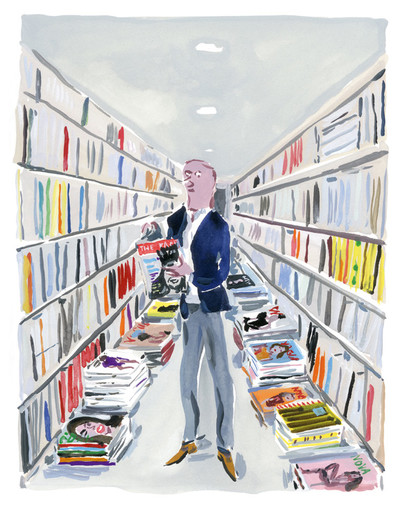The world’s largest magazine collection goes digital.
By James Hyman
Illustration by Jean-Philippe Delhomme
The world’s largest magazine collection goes digital.

‘If you don’t have a dream, how you gonna have a dream come true?’ wrote Rodgers and Hammerstein, and to realize any dream, ‘you gotta have faith’, as George Michael sang. Excuse my song-based habit, but lyrics often best sum up how I feel and why I do what I do. Because I have a dream and I have absolute faith in its coming true. For me, magazines are ‘always on my mind’.
Thanks to 30 years in the media business (presenting and producing for MTV and the BBC; working in music, film and print) I have amassed what has been referred to as ‘a walk-in Google’ of magazines. In fact, I now hold the Guinness world record for owning the ‘largest collection of magazines in the world’. It currently contains over 100,000 issues, is growing at 30 percent a year (mainly thanks to extremely generous donations from collectors to whom I am eternally grateful), and is unique: over 55 percent of its titles are not held by the British Library. I am currently working to turn this collection, now called the Hyman Archive, into a new resource for all, and so taking the first steps towards my ultimate dream. Since my early teens, my idée fixe has been to collect and share popular culture. My professional life began in 1988 when I joined the just-launched MTV Europe as a scriptwriter. I had to provide content for the VJs that would amaze, amuse and always entertain the channel’s huge and diverse audience. Where best to source such information? Magazines, of course! Pre-Internet, the millions of publications on news stands around the world truly were our Google. Yet even then I knew that much of that contemporary print would be forgotten – tomorrow’s fish and chip paper – and I knew I had to save it.
Since then, it’s been an incredible journey and along the way I’ve met amazing characters who share my unrelenting passion for preserving print. People like Edda ‘Scissor Sister’ Tasiemka who has dedicated much of her life to snipping and cataloguing newspaper and magazine articles. Or Danny Posner who gave me the bug for collecting when I clocked the May 1984 ‘Electro’ cover of The Face in his now sadly closed Vintage Magazine Shop in London’s Soho. It was there in a basement filled with back issues that my magazine mania was born.
My archive’s collection of pop-culture press now spans from 1850 to present day. Organized into sections, such as fashion, film and TV, music, sport, technology, politics, art, counterculture, design, photography and lifestyle, it contains issues of 1920s Vogue; 1930s National Geographic; 1940s Melody Maker; 1950s Playboy; 1960s Private Eye; 1970s Nova; 1980s Smash Hits; and 1990s Entertainment Weekly. Not to mention plenty of obscure titles such as Girls Like Corpses, Factsheet 5, Modern Drunkard and 2600 – all arguably of cultural significance, all passionate publishing.
Our next step is to transform all that paper into digital content on a definitive platform with sophisticated search and analytical tools. Call it a ‘Spotify for magazines’ that will function as a subscription business, respecting copyright and ensuring that rights holders are paid royalties, while giving the world an amazing new research resource. Imagine easily being able to search in a specific magazine for the first written mention or image of Kate Moss or to create timelines for a cover star and see how popular she was compared to others. You could discover how Bob Dylan connects to James Bond and President Obama, what joins Stanley Kubrick to Nike trainers, or uncover the roots of hip-hop culture in an unheard-of publication. How about tracking the evolution of brands through their advertising, what’s likely to trend and how. The archive will be a treasure trove of unique, searchable content all in one place.
It is an archive that is going to keep expanding, too, because whatever you might be hearing, digital is not dominating everything and print is definitely not dead. Indeed, magazines are experiencing a sustained renaissance as readers once again appreciate the pleasure of paper and the physical object. When film director Christopher Nolan guest-edited Wired, he wrote that: ‘A magazine offers a far more comfortable relationship with time – we can flick through it, stop, flip back, keep it forever. It can do a good job of representing spatial dimensions through photography and design.’
Physical manifestations of writing have been around since humans lived in caves and all media – including TV, film and the Internet – rely on print. So today, as the physical Hyman Archive becomes a digital reality, I am proud and thrilled to be using the best of today’s technology to help bring the joy of printed media to a new and far wider audience.